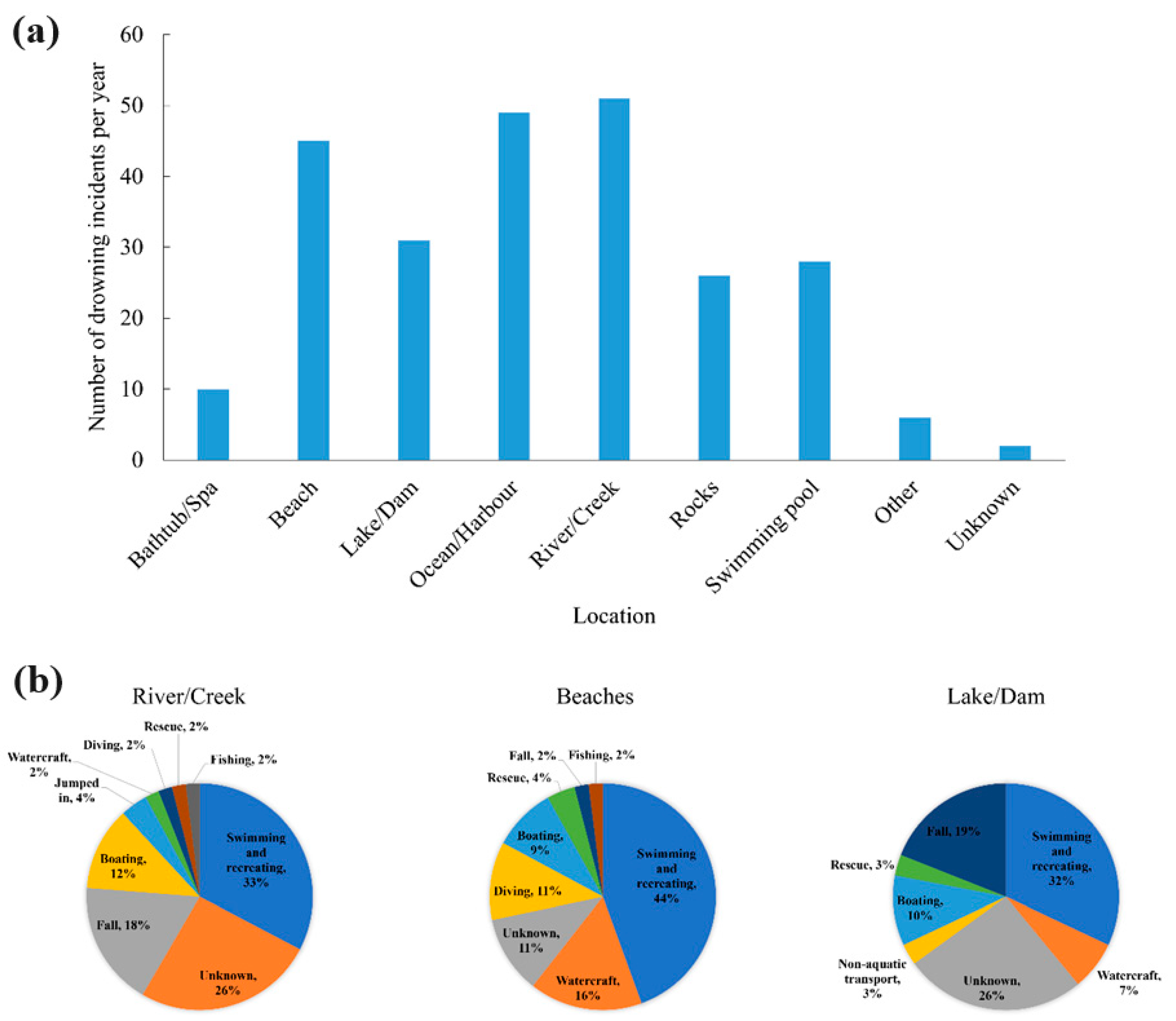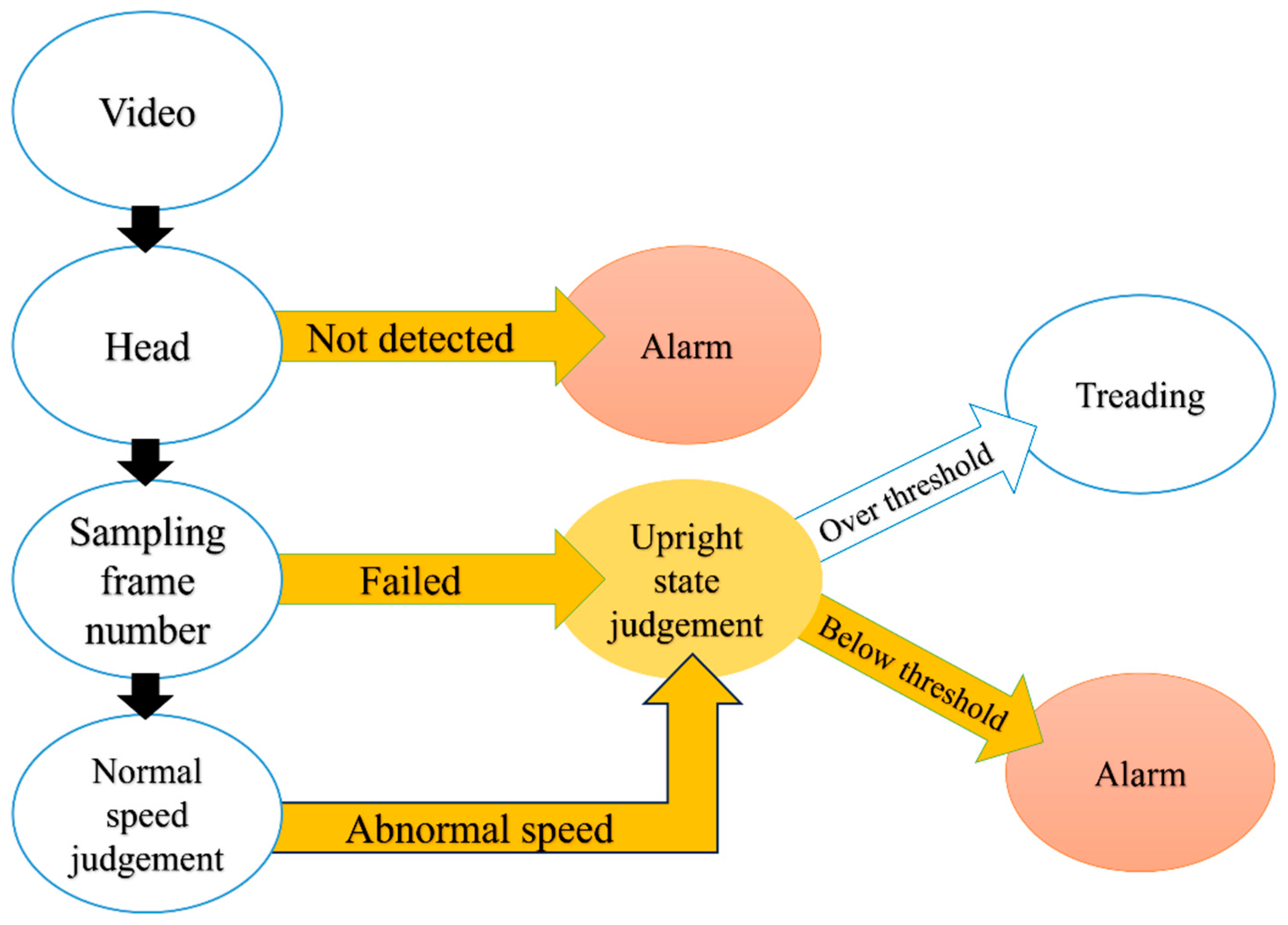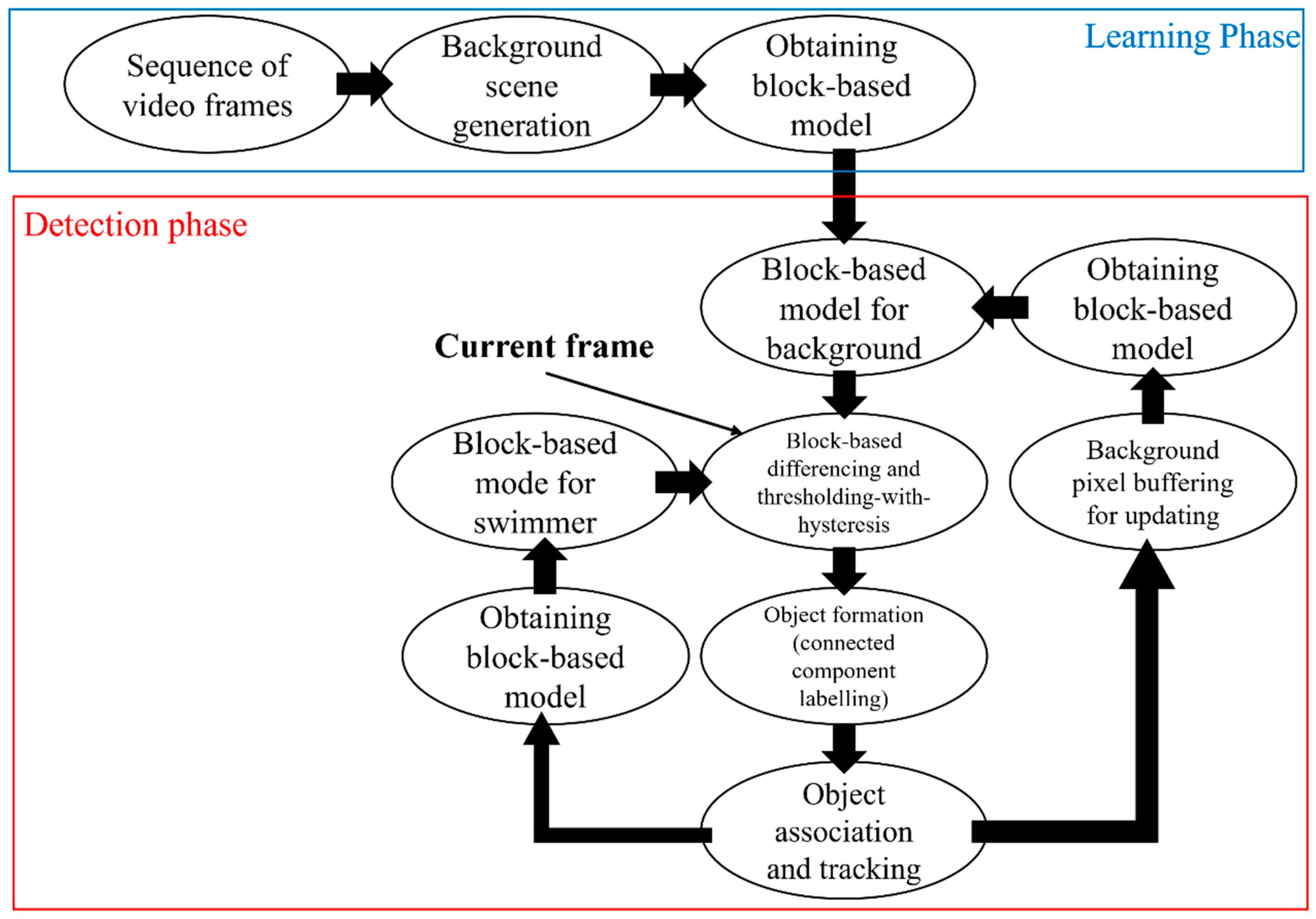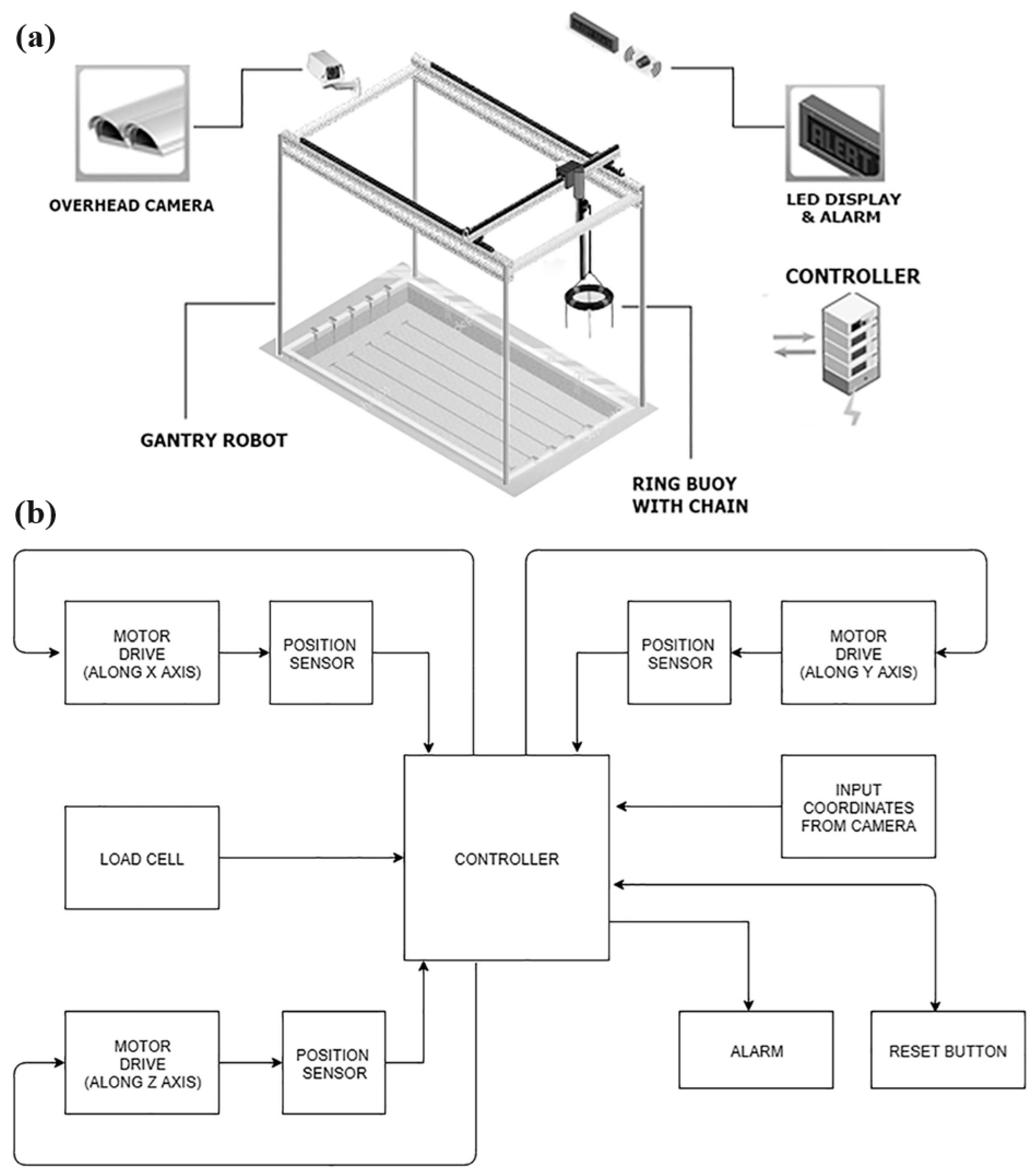Enhancing Water Safety: Exploring Recent Technological Approaches for Drowning Detection
Abstract
:1. Introduction
2. Drowning Behaviour, Signs, and Statistics
3. Image Processing Techniques for Drowning Detection
4. Sensor-Based Techniques for Drowning Detection
4.1. Measurable Behaviour
4.1.1. Heart Rate
4.1.2. Blood Oxygen Saturation
4.1.3. Depth
4.1.4. Body Temperature
4.1.5. Time Duration
4.2. Developed Domestic Sensor-Based Devices for Children
5. Conclusions
Author Contributions
Funding
Conflicts of Interest
References
- World Health Organization. 2021. Available online: https://www.who.int/news-room/fact-sheets/detail/drowning (accessed on 2 January 2024).
- Franklin, R.C.; Peden, A.E.; Hamilton, E.B.; Bisignano, C.; Castle, C.D.; Dingels, Z.V.; Hay, S.I.; Liu, Z.; Mokdad, A.H.; Roberts, N.L. The burden of unintentional drowning: Global, regional and national estimates of mortality from the Global Burden of Disease 2017 Study. Inj. Prev. 2020, 26 (Suppl. S2), i83–i95. [Google Scholar] [CrossRef] [PubMed]
- Peden, A.E.; Franklin, R.C.; Mahony, A.J.; Scarr, J.; Barnsley, P.D. Using a retrospective cross-sectional study to analyse unintentional fatal drowning in Australia: ICD-10 coding-based methodologies verses actual deaths. BMJ Open 2017, 7, e019407. [Google Scholar] [CrossRef] [PubMed]
- Jalalifar, S.; Kashizadeh, A.; Mahmood, I.; Belford, A.; Drake, N.; Razmjou, A.; Asadnia, M. A smart multi-sensor device to detect distress in swimmers. Sensors 2022, 22, 1059. [Google Scholar] [CrossRef]
- Rahman, A.; Peden, A.E.; Ashraf, L.; Ryan, D.; Bhuiyan, A.-A.; Beerman, S. Drowning: Global burden, risk factors, and prevention strategies. In Oxford Research Encyclopedia of Global Public Health; Oxford University Press: Oxford, UK, 2021. [Google Scholar]
- Kim, D.Y.; Lee, S.; Nho, S.M.; Kwon, O.Y.; Kim, D.J. Review of washing machine-related deaths in South Korea. Leg. Med. 2022, 54, 101994. [Google Scholar] [CrossRef] [PubMed]
- Li, D.-R.; Quan, L.; Zhu, B.-L.; Ishikawa, T.; Michiue, T.; Zhao, D.; Yoshida, C.; Chen, J.-H.; Wang, Q.; Komatsu, A.; et al. Evaluation of postmortem calcium and magnesium levels in the pericardial fluid with regard to the cause of death in medicolegal autopsy. Leg. Med. 2009, 11, S276–S278. [Google Scholar] [CrossRef] [PubMed]
- Stephenson, L.; Stockham, P.; van den Heuvel, C.; Byard, R.W. Characteristics of drowning deaths in an inner city river. Leg. Med. 2020, 47, 101783. [Google Scholar] [CrossRef]
- Pitman, S.J.; Wright, M.; Hocken, R. An analysis of lifejacket wear, environmental factors, and casualty activity on marine accident fatality rates. Saf. Sci. 2019, 111, 234–242. [Google Scholar] [CrossRef]
- Eshed, E. IoT News. Available online: https://www.iottechnews.com/news/2015/oct/27/saving-lives-iot-streamlining-search-and-rescue-efforts-using-lte-technology/ (accessed on 2 January 2024).
- Cepeda-Pacheco, J.C.; Domingo, M.C. Deep learning and 5G and beyond for child drowning prevention in swimming pools. Sensors 2022, 22, 7684. [Google Scholar] [CrossRef]
- Kałamajska, E.; Misiurewicz, J.; Weremczuk, J. Wearable Pulse Oximeter for Swimming Pool Safety. Sensors 2022, 22, 3823. [Google Scholar] [CrossRef]
- Peden, M.M.; McGee, K. The epidemiology of drowning worldwide. Inj. Control Saf. Promot. 2003, 10, 195–199. [Google Scholar] [CrossRef]
- Tyler, M.D.; Richards, D.B.; Reske-Nielsen, C.; Saghafi, O.; Morse, E.A.; Carey, R.; Jacquet, G.A. The epidemiology of drowning in low-and middle-income countries: A systematic review. BMC Public Health 2017, 17, 413. [Google Scholar] [CrossRef] [PubMed]
- Girela-Lópeza, E.; Beltran-Arocaa, C.M.; Dye, A.; Gill, J.R. Epidemiology and autopsy findings of 500 drowning deaths. Forensic Sci. Int. 2022, 330, 111137. [Google Scholar] [CrossRef] [PubMed]
- Australian Governmnent. Royal Life Saving National Drowning Report 2020. 2020. Available online: https://www.royallifesaving.com.au/__data/assets/pdf_file/0003/33861/RLS_NationalDrowningReport2020LR-FINAL.pdf (accessed on 2 January 2024).
- Van Beeck, E.F.; Branche, C.M.; Szpilman, D.; Modell, J.H.; Bierens, J.J. A new definition of drowning: Towards documentation and prevention of a global public health problem. Bull. World Health Organ. 2005, 83, 853–856. [Google Scholar] [PubMed]
- Watson, K.; Healthline. Drowning Facts and Safety Precautions. 2020. Available online: https://www.healthline.com/health/dry-drowning (accessed on 2 January 2024).
- Fletcher, J.; Medical News Today. 8 November 2023. Available online: https://www.medicalnewstoday.com/articles/how-long-can-the-average-person-hold-their-breath#benefits (accessed on 2 January 2024).
- Modell, J.H. Drowning. N. Engl. J. Med. 1993, 328, 253–256. [Google Scholar] [CrossRef] [PubMed]
- Harle, L. PathologyOutlines.com. 2012. Available online: https://www.pathologyoutlines.com/topic/forensicsdrowning.html (accessed on 2 January 2024).
- Peden, A.E.; Mahony, A.J.; Barnsley, P.D.; Scarr, J. Understanding the full burden of drowning: A retrospective, cross-sectional analysis of fatal and non-fatal drowning in Australia. BMJ Open 2018, 8, e024868. [Google Scholar] [CrossRef] [PubMed]
- Ma, W.J.; Nie, S.P.; Xu, H.F.; Xu, Y.J.; Song, X.L.; Guo, Q.Z.; Zhang, Y.R. An analysis of risk factors of non-fatal drowning among children in rural areas of Guangdong Province, China: A case-control study. BMC Public Health 2010, 10, 156. [Google Scholar] [CrossRef] [PubMed]
- Felton, H.; Myers, J.; Liu, G.; Davis, D.W. Unintentional, non-fatal drowning of children: US trends and racial/ethnic disparities. BMJ Open 2015, 5, e008444. [Google Scholar] [CrossRef]
- Al-Qurashi, F.O.; Yousef, A.A.; Aljoudi, A.; Alzahrani, S.M.; Al-Jawder, N.Y.; Al-Ahmar, A.K.; Al-Majed, M.S.; Abouollo, H.M. A review of nonfatal drowning in the pediatric-age group: A 10-year experience at a university hospital in Saudi Arabia. Pediatr. Emerg. Care 2019, 35, 782–786. [Google Scholar] [CrossRef]
- Reijnen, G.; van de Westeringh, M.; Buster, M.; Vos, P.; Reijnders, U. Epidemiological aspects of drowning and non-fatal drowning in the waters of Amsterdam. J. Forensic Leg. Med. 2018, 58, 78–81. [Google Scholar] [CrossRef]
- Matthews, B.L.; Andrew, E.; Andronaco, R.; Cox, S.; Smith, K. Epidemiology of fatal and non-fatal drowning patients attended by paramedics in Victoria, Australia. Int. J. Inj. Control Saf. Promot. 2017, 24, 303–310. [Google Scholar] [CrossRef]
- Centers for Disease Control and Prevention. Drowning Prevention. Available online: https://www.cdc.gov/drowning/facts/index.html (accessed on 12 March 2023).
- Denny, S.A.; Quan, L.; Gilchrist, J.; McCallin, T.; Shenoi, R.; Yusuf, S.; Weiss, J.; Hoffman, B. Prevention of drowning. Pediatrics 2021, 148, e2021052227. [Google Scholar] [CrossRef]
- Barnsley, P.D.; Peden, A.E.; Scarr, J. Calculating the economic burden of fatal drowning in Australia. J. Saf. Res. 2018, 67, 57–63. [Google Scholar] [CrossRef]
- Berzansky, D. Premier Aquatics. 2015. Available online: https://swimoc.com/recognizing-the-quiet-signs-of-drowning/#:~:text=Waiving%20arms%20%E2%80%93%20Don’t%20look (accessed on 2 January 2024).
- Ezer, O.; Banin, Y.; Almog, G. Detecting and Notifying of Drowning Conditions in a Swimmer. U.S. Patent 20090309739A1, 17 June 2008. [Google Scholar]
- Lygouras, E.; Santavas, N.; Taitzoglou, A.; Tarchanidis, K.; Mitropoulos, A.; Gasteratos, A. Unsupervised Human Detection with an Embedded Vision System on a Fully Autonomous UAV for Search and Rescue Operations. Sensors 2019, 19, 3552. [Google Scholar] [CrossRef]
- Homier, V.; de Champlain, F.; Nolan, M.; Fleet, R. Identification of Swimmers in Distress Using Unmanned Aerial Vehicles: Experience at the Mont-Tremblant IRONMAN Triathlon. Prehospital Emerg. Care 2020, 24, 451–458. [Google Scholar] [CrossRef]
- Redmon, J.C.; Farhadi, A. YOLO: Real-Time Object Detection. Available online: https://pjreddie.com/darknet/yolo/ (accessed on 2 January 2024).
- Bochkovskiy, A. Scaled-YOLOv4: Scaling Cross Stage Partial Network. In Proceedings of the IEEE/CVF Conference on Computer Vision and Pattern Recognition (CVPR), 2021, Nashville, TN, USA, 20–25 June 2021. [Google Scholar]
- Yun, S.; Kim, S. Recurrent YOLO and LSTM-based IR single pedestrian tracking. In Proceedings of the 19th International Conference on Control, Automation and Systems (ICCAS 2019), Jeju, Republic of Korea, 15–18 October 2019. [Google Scholar]
- Jinsong, L.; Philipsen, M.P.; Moeslund, T.B. Supervised versus Self-supervised Assistant for Surveillance of Harbor Fronts. In Proceedings of the 16th International Conference on Computer Vision Theory and Applications, Vienna, Austria, 8–10 February 2021; pp. 610–617. [Google Scholar]
- Bonderup, S.; Olsson, J.; Bonderup, M.; Moeslund, T.B. Preventing Drowning Accidents Using Thermal Cameras. In Proceedings of Advances in Visual Computing; Springer: Cham, Switzerland, 2016. [Google Scholar]
- Li, D.; Yu, L.; Jin, W.; Zhang, R.; Feng, J.; Fu, N. An Improved Detection Method of Human Target at Sea Based on Yolov3. In Proceedings of the IEEE International Conference on Consumer Electronics and Computer Engineering (ICCECE), Guangzhou, China, 15–17 January 2021; pp. 100–103. [Google Scholar]
- Shiuuee, K.; Rezaei, F. A presentation of drowning detection system on coastal lines using image processing techniques and neural network. J. Inj. Violence Res. 2019, 11, 18. [Google Scholar]
- Eng, H.L.; Toh, K.A.; Kam, A.H.; Wang, J.; Yau, W.Y. An automatic drowning detection surveillance system for challenging outdoor pool environments. In Proceedings of the Ninth IEEE International Conference on Computer Vision (ICCV’03), Nice, France, 13–16 October 2003. [Google Scholar]
- Eng, H.L.; Toh, K.A.; Yau, W.Y.; Wang, J. DEWS: A Live Visual Surveillance System for Early Drowning Detection at Pool. IEEE Trans. Circuits Syst. Video Technol. 2008, 18, 196–210. [Google Scholar]
- Rooz, E.; Ben-Sira, I. Method and System for Detecting a Motionless Body in a Pool. U.S. Patent 5043705A, 27 August 1991. [Google Scholar]
- Menoud, E. Alarm and Monitoring Device for the Presumption of Bodies in Danger in a Swimming Pool. U.S. Patent 5886630A, 23 March 1999. [Google Scholar]
- Chan, Y.T.; Hou, T.W.; Huang, Y.L.; Lan, W.H.; Wang, P.C.; Lai, C.T. Implementation of deep-learning-based edge computing for preventing drowning In Proceedings of the 8th IIAE International Conference on Industrial Application Engineering, Matsue, Japan, 26–30 March 2020.
- Dalal, N.; Triggs, B. Histograms of oriented gradients for human detection. In Proceedings of the IEEE Computer Society Conference on Computer Vision and Pattern Recognition (CVPR’05), San Diego, CA, USA, 20–25 June 2005; pp. 886–893. [Google Scholar]
- Dalal, N.; Triggs, B.; Schmid, C. Human Detection Using Oriented Histograms of Flow and Appearance. In Proceedings of Computer Vision; Springer: Berlin/Heidelberg, Germany, 2006. [Google Scholar]
- Zhang, D.; Gatica-Perez, D.; Bengio, S.; McCowan, I. Semi-supervised adapted HMMs for unusual event detection. In Proceedings of the IEEE Computer Society Conference on Computer Vision and Pattern Recognition (CVPR’05), San Diego, CA, USA, 20–25 June 2005. [Google Scholar]
- Mahadevan, V.; Li, W.; Bhalodia, V.; Vasconcelos, N. Anomaly detection in crowded scenes. In Proceedings of the IEEE Computer Society Conference on Computer Vision and Pattern Recognition, San Francisco, CA, USA, 18–20 June 1996; pp. 1975–1981. [Google Scholar]
- Xu, D.; Ricci, E.; Yan, Y.; Song, J.; Sebe, N. Learning Deep Representations of Appearance and Motion for Anomalous Event Detection. arXiv 2005, arXiv:1510.01553. [Google Scholar]
- Hasan, M.; Choi, J.; Neumann, J.; Roy-Chowdhury, A.K.; Davis, L.S. Learning Temporal Regularity in Video Sequences. In Proceedings of the IEEE Conference on Computer Vision and Pattern Recognition, Las Vegas, NV, USA, 27–30 June 2016; pp. 733–742. [Google Scholar]
- Zhou, S.; Shen, W.; Zeng, D.; Fang, M.; Wei, Y.; Zhang, Z. Spatial–temporal convolutional neural networks for anomaly detection and localization in crowded scenes. Signal Process. Image Commun. 2016, 47, 358–368. [Google Scholar] [CrossRef]
- Wang, F.; Ai, Y.; Zhang, W. Detection of early dangerous state in deep water of indoor swimming pool based on surveillance video. Signal Image Video Process. 2022, 16, 29–37. [Google Scholar] [CrossRef]
- Hayat, M.A.; Yang, G.; Iqbal, A.; Saleem, A.; Mateen, M. Comprehensive and Comparative Study of Drowning Person Detection and Rescue Systems. In Proceedings of the 8th International Conference on Information and Communication Technologies (ICICT), Karachi, Pakistan, 16–17 November 2019. [Google Scholar]
- He, X.; Yuan, F.; Zhu, Y. Drowning Detection Based on Video Anomaly Detection. In Proceedings of the Image and Graphics: 11th International Conference, ICIG 2021, Haikou, China, 6–8 August 2021; Volume 12890, pp. 700–711. [Google Scholar]
- Kam, A.H.; Lu, W.; Yau, W.-Y. A Video-Based Drowning Detection System. In Proceedings of the 7th European Conference on Computer Vision, Copenhagen, Denmark, 28–31 May 2002; pp. 297–311. [Google Scholar]
- Zhang, C.; Li, X.; Lei, F. A Novel Camera-Based Drowning Detection Algorithm. In Proceedings of the 10th Chinese Conference, Advances in Image and Graphics Technologies IGTA, Beijing, China, 19–20 June 2015. [Google Scholar]
- Laxman, P.; Jain, A. Analysis of Novel Assistive Robotic Multi-Stage Underwater Lift Design for Swimmer Safety. J. Eng. 2022, 2022, 746–759. [Google Scholar] [CrossRef]
- Lu, W.; Tan, Y.P. A camera-based system for early detection of drowning incidents. In Proceedings of the International Conference on Image Processing, Rochester, NY, USA, 22–25 September 2002. [Google Scholar]
- Jose, A.; Udupa, G. Gantry robot system for preventing drowning accidents in swimming pools. Mater. Today Proc. 2021, 46, 4975–4981. [Google Scholar] [CrossRef]
- Anderson, D.B.; Barnett, J.T.; Hakes, D.L.; Loss, K.R.; Gormican, J.P. Above-Water Monitoring of Swimming Pools. U.S. Patent 8237574B2, 7 August 2012. [Google Scholar]
- Chaudhari, T.K.Y.; Pandit, G.; Gupta, P.; Kumar, M. Anti Drowning system using remote control. IOSR J. Eng. 2016, 1, 38–42. [Google Scholar]
- Kulkarni, A.; Lakhani, K.; Lokhande, S. A sensor based low-cost drowning detection system for human life safety. In Proceedings of the International Conference on Reliability, Infocom Technologies and Optimization (ICRITO) (Trends and Future Directions), Noida, India, 7–9 September 2016. [Google Scholar]
- Abolpour Moshizi, S.; Moradi, H.; Wu, S.; Han, Z.J.; Razmjou, A.; Asadnia, M. Biomimetic ultraflexible piezoresistive flow sensor based on graphene nanosheets and PVA hydrogel. Adv. Mater. Technol. 2022, 7, 2100783. [Google Scholar] [CrossRef]
- Moshizi, S.A.; Abedi, A.; Pastras, C.J.; Peng, S.; Wu, S.; Sanaeepur, M.; Asadnia, M. Carbon nanofiber-reinforced Pt thin film-based airflow sensor for respiratory monitoring. Sens. Actuators A Phys. 2022, 347, 113969. [Google Scholar] [CrossRef]
- Moshizi, S.A.; Abedi, A.; Sanaeepur, M.; Pastras, C.J.; Han, Z.J.; Wu, S.; Asadnia, M. Polymeric piezoresistive airflow sensor to monitor respiratory patterns. J. R. Soc. Interface 2021, 18, 20210753. [Google Scholar] [CrossRef]
- Vahdani, M.; Mirjalali, S.; Karlapudi, M.C.; Moshizi, S.A.; Kim, J.; Huang, S.; Asadnia, M.; Peng, S.; Wu, S. Highly stretchable strain sensors based on gold thin film reinforced with carbon nanofibers. Smart Mater. Manuf. 2023, 1, 100016. [Google Scholar] [CrossRef]
- Ahmadi, H.; Moradi, H.; Pastras, C.J.; Abolpour Moshizi, S.; Wu, S.; Asadnia, M. Development of ultrasensitive biomimetic auditory hair cells based on piezoresistive hydrogel nanocomposites. ACS Appl. Mater. Interfaces 2021, 13, 44904–44915. [Google Scholar] [CrossRef]
- Hemalatha, S.; Nandhini, P.; Vimala, J.; Ramesh, V. Automated Drowning Detection and Security in Swimming Pool. Int. Res. J. Eng. Technol. 2017, 4, 17–21. [Google Scholar]
- John, S.N.; Ukpabio, I.G.; Omoruyi, O.; Onyiagha, G.; Noma-Osaghae, E.; Okokpujie, K.O. Design of a drowning rescue alert system. Int. J. Mech. Eng. Technol. (IJMET) 2019, 10, 1987–1995. [Google Scholar]
- Ramdhan, M.; Ali, M.; Ali, S.; Kamaludin, M.Y. An Early Drowning Detection System for Internet of Things (IoT) Applications. TELKOMNIKA Telecommun. Comput. Electron. Control 2018, 16, 1870–1876. [Google Scholar]
- Ramani, J.G.; Gayathri, J.; Aswanth, R.; Gunasekaran, M. Automatic prevention of drowning by inflatable wrist band system. In Proceedings of the 5th International Conference on Advanced Computing & Communication Systems (ICACCS), Coimbatore, India, 15–16 March 2019; pp. 346–349. [Google Scholar]
- Nagalikitha, S.; Kiranmai, A.V. Automatic Waist Airbag Drowning Prevention System Based on Motion Information Measured by Memos Accelerometer and Pressure. Int. J. Emerg. Trends Eng. Res. (IJETER) 2015, 3, 204–206. [Google Scholar]
- Shehata, A.M.; Mohamed, E.M.; Salem, K.L.; Mohamed, A.M.; Abdul Salam, M.; Gamil, M.M. A Survey of Drowning Detection Techniques. In Proceedings of the International Mobile, Intelligent, and Ubiquitous Computing Conference (MIUCC), Cairo, Egypt, 26–27 May 2021. [Google Scholar]
- Puspitasari, A.J.; Famella, D.; Ridwan, S.M.; Khoiri, M. Design of low-flow oxygen monitor and control system for respiration and SpO2 rates optimization. J. Phys. Conf. Ser. 2020, 1436, 012042. [Google Scholar] [CrossRef]
- Thygerson, A. Deseret News. 1998. Available online: https://www.deseret.com/1998/3/22/19370324/hypothermia-kills-half-of-drowning-victims (accessed on 2 January 2024).
- A NSW Government Website. 2022. Available online: https://www.health.nsw.gov.au/environment/factsheets/Pages/hypothermia.aspx (accessed on 2 January 2024).
- Banting, F.G.; Hall, G.E.; Janes, J.M.; Leibel, B.; Lougheed, S.W. Physiological studies in experimental drowning (A): Preliminary Report. Can. Med. Assoc. J. 1938, 39, 226–228. [Google Scholar]
- Lund, F.K.; Torgersen, J.G.R.; Flaatten, H.K. Heart rate monitored hypothermia and drowning in a 48-year-old man. survival without sequelae: A case report. Cases J. 2009, 2, 6204. [Google Scholar] [CrossRef] [PubMed]
- Hegg, J. Know the Steps to Take to Identify and Treat Low SpO2 Levels. HomeCare: 2016. Available online: https://www.homecaremag.com/understanding-spo2-and-normal-oxygen-levels (accessed on 2 January 2024).
- Lopez, S. Pulse Oximeter Fundamentals; Freescale Semiconductor, Inc.: Austin, TX, USA, 2011. [Google Scholar]
- Guidelines for SpO2 Measurement; Maxim Integrated Products, Inc. Available online: https://www.analog.com/en/technical-articles/guidelines-for-spo2-measurement--maxim-integrated.html#/ (accessed on 2 January 2024).
- Montenij, L.J.; de Vries, W.; Schwarte, L.; Bierens, J.J. Feasibility of pulse oximetry in the initial prehospital management of victims of drowning: A preliminary study. Resuscitation 2011, 82, 1235–1238. [Google Scholar] [CrossRef] [PubMed]
- Reddy, N.K.S.; Murty, O.P. The Essentials of Forensic Medicine and Toxicology; Jaypee Brothers: New Delhi, India, 2015. [Google Scholar]
- Hunsucker, J.L.; Davison, S.J. Analysis of rescue and drowning history from a lifeguarded waterpark environment. Int. J. Inj. Control Saf. Promot. 2011, 18, 277–284. [Google Scholar] [CrossRef] [PubMed]
- Mayo Foundation for Medical Education and Research (MFMER). 2022. Available online: https://www.mayoclinic.org/diseases-conditions/hypothermia/symptoms-causes/syc-20352682#:~:text=Hypothermia%20is%20a%20medical%20emergency,95%20F%20(35%20C) (accessed on 2 January 2024).
- Quan, L.; Mack, C.D.; Schiff, M.A. Association of water temperature and submersion duration and drowning outcome. Resuscitation 2014, 85, 790–794. [Google Scholar] [CrossRef]
- Nishida, Y.; Hiratsuka, K.; Mizoguchi, H. Prototype of Infant Drowning Prevention System at Home with Wireless Accelerometer. In Proceedings of the IEEE Sensors, Atlanta, GA, USA, 28–31 October 2007. [Google Scholar]
- Peden, A.E.; Franklin, R.C. Causes of distraction leading to supervision lapses in cases of fatal drowning of children 0–4 years in Australia: A 15-year review. J. Paediatr. Child Health 2020, 56, 450–456. [Google Scholar] [CrossRef]
- Davies, M.M.; Gissen, L. Daily Mail Australia. 2022. Available online: https://www.dailymail.co.uk/femail/article-10881937/Mom-says-toddlers-heart-stopped-coma-drowning.html (accessed on 2 January 2024).
- Suominen, P.K.; Vähätalo, R. Neurologic long term outcome after drowning in children. Scand. J. Trauma Resusc. Emerg. Med. 2012, 20, 55. [Google Scholar] [CrossRef]
- Ren, P.; Zhang, C.; Liu, X.; Liu, P.; Ci, S. WiEyeTNB: A Wireless Sensor Based Drowning Detection System for Enhanced Parental Care. In Wireless Internet, Proceedings of the 6th Internatinal ICST Conference, WICON 2011, Xi’an, China, 19–21 October 2011; Springer: Berlin/Heidelberg, Germany, 2011; pp. 511–520. [Google Scholar]
- Safety Turtle 2.0 Pool Alarm; RJE Technologies, Inc.: Irvine, CA, USA. Available online: https://www.diycontrols.com/p-9576-safety-turtle-20-child-immersion-poolwater-alarm-kit.aspx (accessed on 2 January 2024).
- Pool & Spa Warehouse. Water Patrol Child Guard—Wireless Anti-Drowning Electronic Device. Available online: https://poolandspawarehouse.com.au/water-patrol-child-guard.html (accessed on 2 January 2024).





| Method | Advantages | Limitations |
|---|---|---|
| Lifeguard |
|
|
| Video processing-drones |
|
|
| Image-processing technology |
|
|
| Wearable sensors |
|
|
| Device | Functionality | Limitations |
|---|---|---|
| Triaxial accelerometer device for bathtub [89] |
|
|
| WiEyeTNB [93] |
|
|
| Safety Turtle Pool Alarm [94], Water Patrol Child Guard [95] |
|
|
Disclaimer/Publisher’s Note: The statements, opinions and data contained in all publications are solely those of the individual author(s) and contributor(s) and not of MDPI and/or the editor(s). MDPI and/or the editor(s) disclaim responsibility for any injury to people or property resulting from any ideas, methods, instructions or products referred to in the content. |
© 2024 by the authors. Licensee MDPI, Basel, Switzerland. This article is an open access article distributed under the terms and conditions of the Creative Commons Attribution (CC BY) license (https://creativecommons.org/licenses/by/4.0/).
Share and Cite
Jalalifar, S.; Belford, A.; Erfani, E.; Razmjou, A.; Abbassi, R.; Mohseni-Dargah, M.; Asadnia, M. Enhancing Water Safety: Exploring Recent Technological Approaches for Drowning Detection. Sensors 2024, 24, 331. https://doi.org/10.3390/s24020331
Jalalifar S, Belford A, Erfani E, Razmjou A, Abbassi R, Mohseni-Dargah M, Asadnia M. Enhancing Water Safety: Exploring Recent Technological Approaches for Drowning Detection. Sensors. 2024; 24(2):331. https://doi.org/10.3390/s24020331
Chicago/Turabian StyleJalalifar, Salman, Andrew Belford, Eila Erfani, Amir Razmjou, Rouzbeh Abbassi, Masoud Mohseni-Dargah, and Mohsen Asadnia. 2024. "Enhancing Water Safety: Exploring Recent Technological Approaches for Drowning Detection" Sensors 24, no. 2: 331. https://doi.org/10.3390/s24020331
APA StyleJalalifar, S., Belford, A., Erfani, E., Razmjou, A., Abbassi, R., Mohseni-Dargah, M., & Asadnia, M. (2024). Enhancing Water Safety: Exploring Recent Technological Approaches for Drowning Detection. Sensors, 24(2), 331. https://doi.org/10.3390/s24020331







